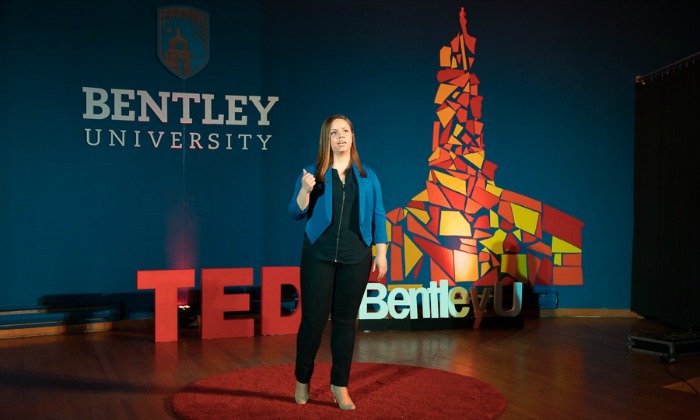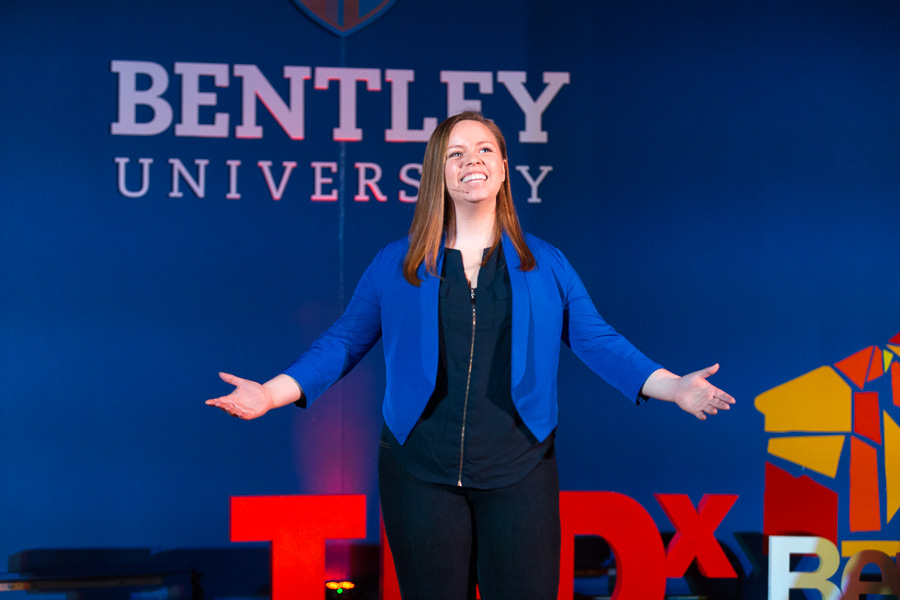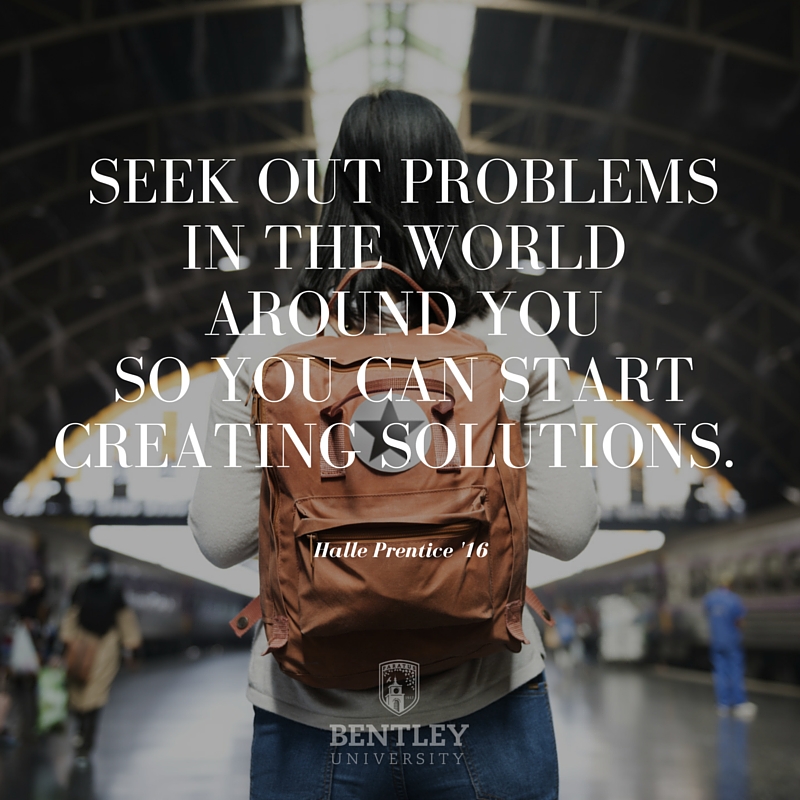
Halle Prentice '16 is a marketing major at Bentley University. This article is condensed from a talk she gave at the 2016 Tedx BentleyU event.
Gray is my favorite color.
Most people think gray is dull, boring, lifeless. Some say it isn’t even a color. But I love gray, and here’s why: Life isn’t all black and white. There’s black and there’s white, but in between there exists a whole lot of gray. It’s everything that becomes possible; all the potential that lives and lurks in the gray that makes it my favorite.
Black and white refers to the predictable parts of life: those with an equation or “right” answer, an obvious set of instructions and consequences.
Why embracing the gray areas of life can unleash new opportunities #bentleyu #preparedu
TWEET THIS
Gray is the opposite: uncharted territory, unexpected circumstances, unplanned challenges and unparalleled opportunities. There’s no instruction booklet or predictability.
It wasn’t until college that I realized how my perception of the gray wasn’t the norm. Gray is my home; I actually feel more uncomfortable reading through the black and white chapters of life. But to my peers, it was the bad neighborhood that they purposely avoided on the way home.
Finding Your Own Answers in Life
How did I become such a “gray” person? My parents raised me in a very gray way that became this set of beliefs and approach to life. They never gave me the answers to anything—not math homework, not friendship crises, not my “expensive taste but empty wallet” problems. Nothing.
Because they never gave me the “right” answers—never let me live in a “black and white” world—I grew accustomed to the gray, working with questions and problems that didn’t have right answers or instructions. I naturally learned how to approach problems in terms of three factors:
- Capabilities
Some memorable sayings from my parents: “Are you going to let the vacuum cleaner be smarter than you?” (when I couldn’t get it to work), and “God gave you a legs for a reason” (when I was being lazy).
- Resources
Just because the answer didn’t lie within me, it didn’t mean it wasn’t close by. Mom’s answer to “But I have no clue how to do this” was “Then who does?” And Dad: “Good thing we have over 100 volumes of encyclopedias in the attic.”
(Sometimes you have to learn how to ask a question.)
- Options
My parents would always tell me that I have unlimited options—some that are obvious, others that I’d have to create myself.
I was also encouraged to follow my curiosities, even when they led me straight into the gray.
Failure Is Not a Bad Thing
I was seven years old when I started my first business: buying candy bars (in bulk) and selling them to friends. I had gone bankrupt at least three times before I was 12, and every time one of my plans backfired or a great idea didn’t come to fruition, my father would put it into perspective:
- “But are you dead?” (No)
- “Are you starving?” (No)
- “Are there people in this world who love you?” (Yes)
- “Did you learn anything?” (Yes)
- “Do you have more great ideas?” (Yes)
- “Then what’s the problem?” (There isn’t one)
My own little-kid brain finally determined that failure was not a bad thing. Risk wouldn’t ruin me. Every idea and every project didn’t have to go as planned to be considered a success. Gray was my playground.
Every project doesn’t have to go as planned to be considered a success #bentleyu #preparedu
TWEET THIS
Don’t Fear the Gray
Gray is the reason I spent a summer in China learning a language and a culture that had nothing to do with my life. It’s the reason I turned down a great opportunity to work in government so that I could study cupcakes.
Gray. I loved it there.
Black and white is seen as a comfort zone; gray is considered a “danger zone.” Gray is all about risk, whereas black and white is all about results. Somewhere between our personal and professional lives, we’ve been taught that if we can just avoid the gray, if we can just cling tightly to the black and white approach to life, we’ll get results.
The results may not be great…but they’ll be good enough. They may not bring you joy… but they’ll bring you a paycheck every two weeks. You may have a spirit that hungers for more…but your stomach will never by empty.
There is certainly some promise, some security, in the black and white aspects of life, but we are giving up so much—as individuals, as a society—by living in fear of the gray. Where “black and white” people see problems, “gray” people see opportunities. That’s the key word: opportunity.
“It’s not what you look at that matters, it’s what you see.”
Henry David Thoreau
I think author Henry David Thoreau phrased it best when he said: “It’s not what you look at that matters, it’s what you see.”
Life’s toughest questions are gray. In those moments, it doesn’t matter how many right answers or effective equations you’ve accumulated over your lifetime; black and white solutions don’t solve gray problems.
I’m not trying to convert the world into seven billion “gray enthusiasts.” I know that some people will love it and others will simply tolerate it. The goal is simply not to fear it.
How I’m Living the Gray Life
I came to college, majored in marketing, did a bunch of internships, had a beautiful resume and great GPA, got to senior year and decided, “I’m not really feeling that whole full-time job thing.”
For some people, the problem is not finding a job. For others, it’s not wanting one. Both valid in the eyes of gray people. This was my problem. But it was also my opportunity.
I used my trusty three-factor process, assessing my capabilities, resources and options, to arrive at a solution. What did I decide to do?
What did I decide to do?
After graduation, I’m joining a group of people to bike 4,000 miles across the country and raise money for cancer. 70 days later, when I arrive on the West Coast, I’ll catch a red-eye to Miami, move into an apartment with nothing but my duffle bag, and spend a year serving in an under-resourced public school.
Certainly not the “right answer”, but, just as certainly, a great one.
This is what’s so exciting about the gray. The second I stepped away from the black and white options for my life, I found myself in a more colorful experience than the black and white could ever provide me.
I’ve found that in my life, the gray has been a blessing. In the face of gray answers, I’ve tackled my weaknesses and fears. I’ve met incredible people, been to exciting places and gained immeasurable amounts of perspective and purpose. In the face of gray answers, I’ve learned both humility and pride.
Embrace More Opportunities
Does this sound like a mindset you’re interested in adopting? Here are some of the ways you can “become gray” and embrace more chances:
- Welcome the Process
There’s an old proverb that says: “A wet man no longer fears the rain”. It’s not the being wet that scares us. It’s the becoming wet. The transition, the change, the growth is what can feel terrifying. But we all need to grow. Every time you and the gray are in a knockout fight, someone is going to win. And there’s no reason it can’t be you.
- Shift Your Focus
 Stop focusing on what you’re looking at, and start focusing on what you see. Seek out problems in your life and in the world around you, so you can start creating solutions. Big problems, small problems, gray-as-they-come problems.
Stop focusing on what you’re looking at, and start focusing on what you see. Seek out problems in your life and in the world around you, so you can start creating solutions. Big problems, small problems, gray-as-they-come problems.
- Start Small
Don’t start with large gray problems that have your emotions involved and your future on the line. Use problems that don’t hold so much weight, like “The guy that cuts my hair just moved back to California. Now what?”
- Practice
Build problem-solving instincts just like you would build a muscle, with increasing intensity and lots of repetition. Gain experience. Use the process my parents taught me: assess your capabilities, resources and options.
The more you do this, the more you’ll become “fluent” in open-ended questions and unrestricted processes, and the less you’ll crave right answers and obvious options. The more you do this, the less you’ll live in fear and the more you’ll live in awe of the unknown.
Gray will become your playground, too. It will become your home. Gray may even become your favorite color.

